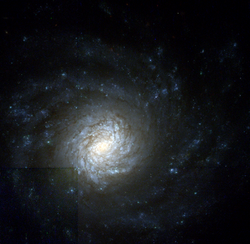Astronomy:NGC 4041
| NGC 4041 | |
|---|---|
 NGC 4041 by the Hubble Space Telescope | |
| Observation data (J2000 epoch) | |
| Constellation | Ursa Major |
| Right ascension | 12h 02m 12.173s[1] |
| Declination | +62° 08′ 14.23″[1] |
| Redshift | 0.004113[2] |
| Helio radial velocity | 1,214[3] |
| Distance | 70.4 Mly (21.57 Mpc)[3] |
| Group or cluster | LGG 266[4] |
| Characteristics | |
| Type | SA(rs)bc?[5] |
| Apparent size (V) | 1.697′ × 1.391′[1] |
| Other designations | |
| 2MASX J12021217+6208142, IRAS 11596+6224 , LEDA 37999, UGC 7014, UZC J120212.2+620814, Z 292-61.[6] | |
NGC 4041 is the New General Catalogue identifier for a spiral galaxy in the northern circumpolar constellation of Ursa Major. It is located an estimated 70 million light years from the Sun.[3] The morphological classification of SA(rs)bc[5] indicates this is a spiral galaxy the lacks a bar; the 'rs' means it has a weakly-formed ring structure, and the 'bc' indicates the spiral arms are moderately to loosely wound.[7]
The galaxy is inclined by around 20° to the line of sight from the Earth.[8] It is forming new stars at the estimated rate of 4.10 M☉ yr−1, which is fairly typical for a galaxy of this morphology. The star formation rate is much higher in the central region, which may be the result of recent merger with a dwarf galaxy within the last 100 million years.[5]
This galaxy has no detected activity in the nuclear region. There is a rotating nuclear disk of high brightness at the core that is consistent with the presence of a compact mass of 1+0.6
−0.7×107 M☉. Most likely this is a supermassive black hole (SMBH).[8][9]
On July 29, 1994, the type IIp supernova designated SN 1994W was discovered in this galaxy by Giancarlo Cortini and Mirko Villi. The event reached peak visual magnitude on August 13, and declined thereafter.[10] It was located about 19 arc seconds to the northwest of the nucleus.[11] This supernova was unusual for the exceptionally low quantity of nickel-56 released—indeed, it was the lowest inferred amount measured for any type II supernova as of that date.[10] Based upon a possible detection of X-ray emission from the remnant, this may be a high-luminosity type IIn supernova.[11]
NGC 4041 is a member of the LGG 266 galaxy group, along with NGC 4036, IC 758, UGC 7009, and UGC 7019. It is located just 17 arc minutes from NGC 4036, and the two form a pair with a projected separation of around 470 kly (143 kpc).[4]
References
- ↑ 1.0 1.1 1.2 Skrutskie, Michael F.; Cutri, Roc M.; Stiening, Rae; Weinberg, Martin D.; Schneider, Stephen E.; Carpenter, John M.; Beichman, Charles A.; Capps, Richard W. et al. (1 February 2006). "The Two Micron All Sky Survey (2MASS)". The Astronomical Journal 131 (2): 1163–1183. doi:10.1086/498708. ISSN 0004-6256. Bibcode: 2006AJ....131.1163S. https://ui.adsabs.harvard.edu/abs/2006AJ....131.1163S/abstract.
- ↑ Kochanek, C. S. et al. (October 2001), "The K-Band Galaxy Luminosity Function", The Astrophysical Journal 560 (2): 566–579, doi:10.1086/322488, Bibcode: 2001ApJ...560..566K.
- ↑ 3.0 3.1 3.2 Crook, Aidan C. et al. (February 2007), "Groups of Galaxies in the Two Micron All Sky Redshift Survey", The Astrophysical Journal 655 (2): 790–813, doi:10.1086/510201, Bibcode: 2007ApJ...655..790C.
- ↑ 4.0 4.1 Cinzano, P. et al. (August 1999), "The kinematics and the origin of the ionized gas in NGC 4036", Monthly Notices of the Royal Astronomical Society 307 (2): 433–448, doi:10.1046/j.1365-8711.1999.02617.x, Bibcode: 1999MNRAS.307..433C.
- ↑ 5.0 5.1 5.2 Konstantopoulos, I. S. et al. (May 2013), "The Snapshot Hubble U-band Cluster Survey (SHUCS). I. Survey Description and First Application to the Mixed Star Cluster Population of NGC 4041", The Astronomical Journal 145 (5): 20, doi:10.1088/0004-6256/145/5/137, 137, Bibcode: 2013AJ....145..137K.
- ↑ "NGC 4041". SIMBAD. Centre de données astronomiques de Strasbourg. http://simbad.u-strasbg.fr/simbad/sim-basic?Ident=NGC+4041.
- ↑ "Classification and Morphology of External Galaxies", Handbuch der Physik, Handbuch der Physik / Encyclopedia of Physics 53: 275–310, 1959, doi:10.1007/978-3-642-45932-0_7, ISBN 978-3-642-45934-4, Bibcode: 1959HDP....53..275D.
- ↑ 8.0 8.1 Barth, Aaron J. (November 2004), Storchi-Bergmann, T.; Ho, L.C.; Schmitt, Henrique R., eds., "Black Hole Masses in Active Galaxies", The Interplay Among Black Holes, Stars and ISM in Galactic Nuclei, Proceedings of IAU Symposium, No. 222 (Cambridge, UK: Cambridge University Press) 2004: pp. 11–13, doi:10.1017/S1743921304001334, ISBN 9780521848039, Bibcode: 2004IAUS..222....3B, https://books.google.com/books?id=4AfLsqU9re4C&pg=PA11.
- ↑ Marconi, A. et al. (April 2003), "Is There Really a Black Hole at the Center of NGC 4041? Constraints from Gas Kinematics", The Astrophysical Journal 586 (2): 868–890, doi:10.1086/367764, Bibcode: 2003ApJ...586..868M.
- ↑ 10.0 10.1 Sollerman, Jesper et al. (January 1998), "A Very Low Mass of 56Ni in the Ejecta of SN 1994W", The Astrophysical Journal 493 (2): 933–939, doi:10.1086/305163, Bibcode: 1998ApJ...493..933S.
- ↑ 11.0 11.1 Schlegel, Eric M. (December 1999), "X-Ray Detection of SN 1994W in NGC 4041?", The Astrophysical Journal 527 (2): L85–L88, doi:10.1086/312408, PMID 10577945, Bibcode: 1999ApJ...527L..85S.
External links
 |

